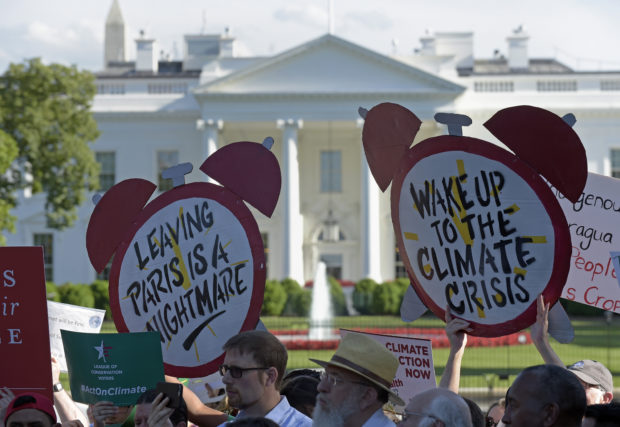
Protesters gather outside the White House in Washington, Thursday, June 1, 2017, to protest President Donald Trump’s decision to withdraw the Unites States from the Paris climate change accord. AP
PARIS—Donald Trump, who on Thursday (Friday, Manila) announced a US withdrawal from the Paris Agreement, is not the first American president to strain international patience by slapping down a climate deal that took years to negotiate.
READ: Trump announces US withdrawal from Paris climate deal
Here is a brief history of America’s checkered involvement in the two-decade-old process that yielded the 2015 Paris accord endorsed by 196 nations — the first universal pact on curbing global warming.
Kyoto
Right from the start, when the UN climate convention was signed in Rio de Janeiro in 1992, the United States resisted any notion of greenhouse gas limits being imposed on countries “top-down”.
Instead, Washington has consistently insisted on national sovereignty when it comes to determining which gases to reduce, how, by how much, and by when.
In 1997, the US joined most of the rest of the world in agreeing to the Kyoto Protocol, which listed binding emissions-curbing targets only for rich nations — those most responsible for carbon pollution blamed for global warming.
The US agreed to the deal after extracting several concessions from negotiating partners.
Bill Clinton’s vice president Al Gore signed the treaty on America’s behalf in 1998, but the Democrat administration could never muster the two-thirds support required from the Senate to officially ratify it.
And when Clinton was replaced by oilman George W. Bush in 2001, the writing was on the wall.
Bush — like his father before him — objected to a pact he said gave developing countries free rein to burn fossil fuels and grow their economies while rich nations’ hands were tied by emissions restrictions.
The pact entered into force without America in 2005 after Russia signed on, tipping the agreement over the legal threshold of 55 ratifiers required.
Canada later withdrew from the deal, and New Zealand, Japan and Russia failed to take on a second round of carbon-cutting pledges.
Copenhagen
In 2009 the world’s nations gathered with the task of replacing the Kyoto Protocol with a new pact requiring action from all countries — including China and India, the world’s first- and third-biggest carbon polluters, and second-placed US.
But talks in the Danish capital ended in near-failure amid bickering between rich and poor countries over how to share responsibility for cuts.
The US, with backing from others, insisted that any deal not be termed a “treaty” that would require Senate ratification, or contain emissions limits that are binding under international law.
In the end, the meeting yielded a non-formal “accord”, which enshrined the target of limiting average global warming to two degrees Celsius (3.6 degrees Fahrenheit) over pre-industrial levels, but listed no emissions targets or cutoff dates.
Paris
The next deadline, set at talks in Durban in 2011, was for a global deal to be finalized by 2015.
US president Barack Obama led with China’s Xi Jinping to rally 195 countries around the common goal.
But with a Republican-dominated Senate back home, he could do only so much.
The end product was a compromise: a legally-binding core agreement that sets out the overarching goals and objectives of limiting warming.
Countries’ intended emissions cuts to this end are listed in a separate non-legally binding register, and are termed “contributions” rather than “commitments”.
This allowed Obama to ratify the agreement without Senate approval, promising the United States would cut emissions by 26-28 percent over 2005 levels by 2025.
But it also means there will be no repercussions apart from a diplomatic cold shoulder for Washington for withdrawing from the pact and breaking its pledge.